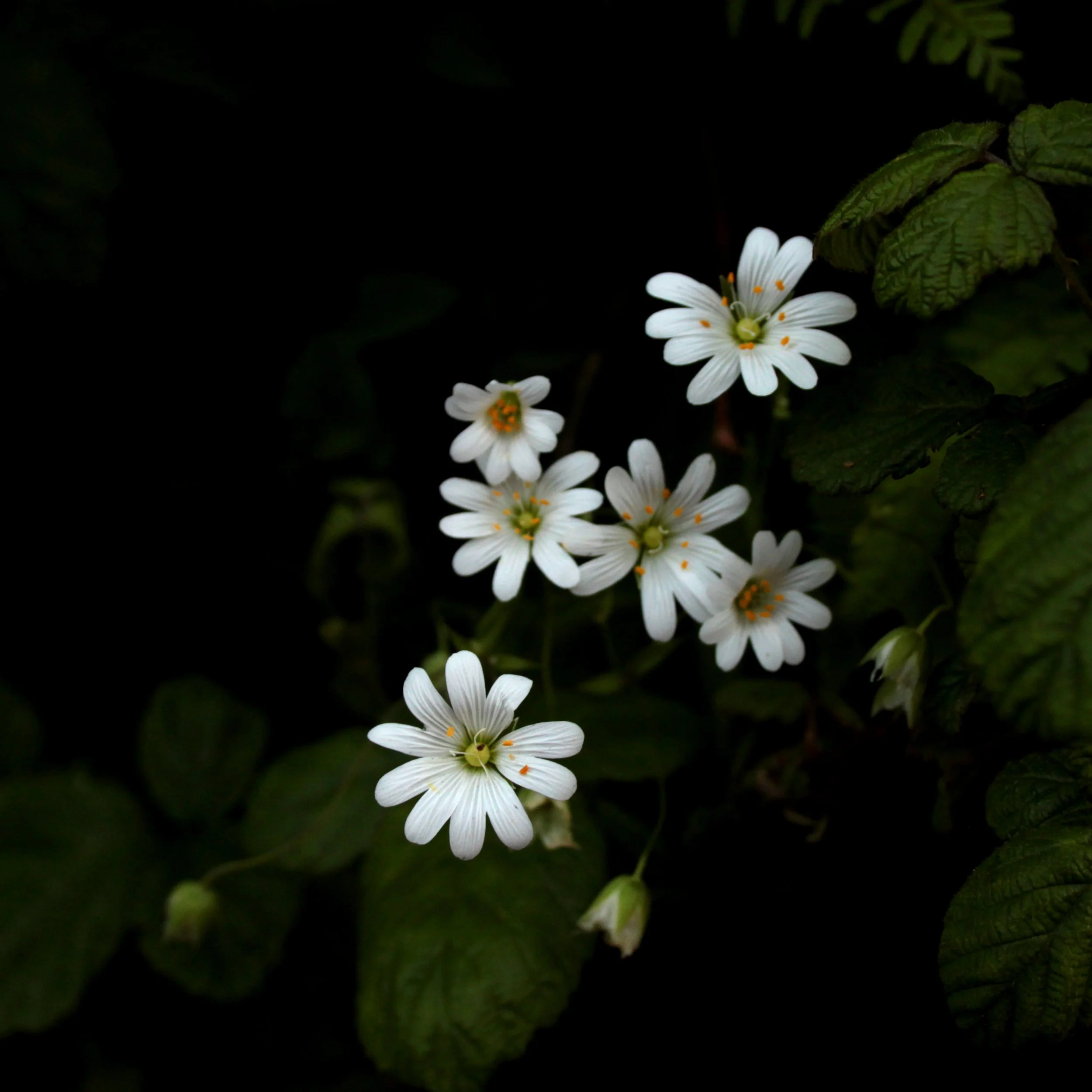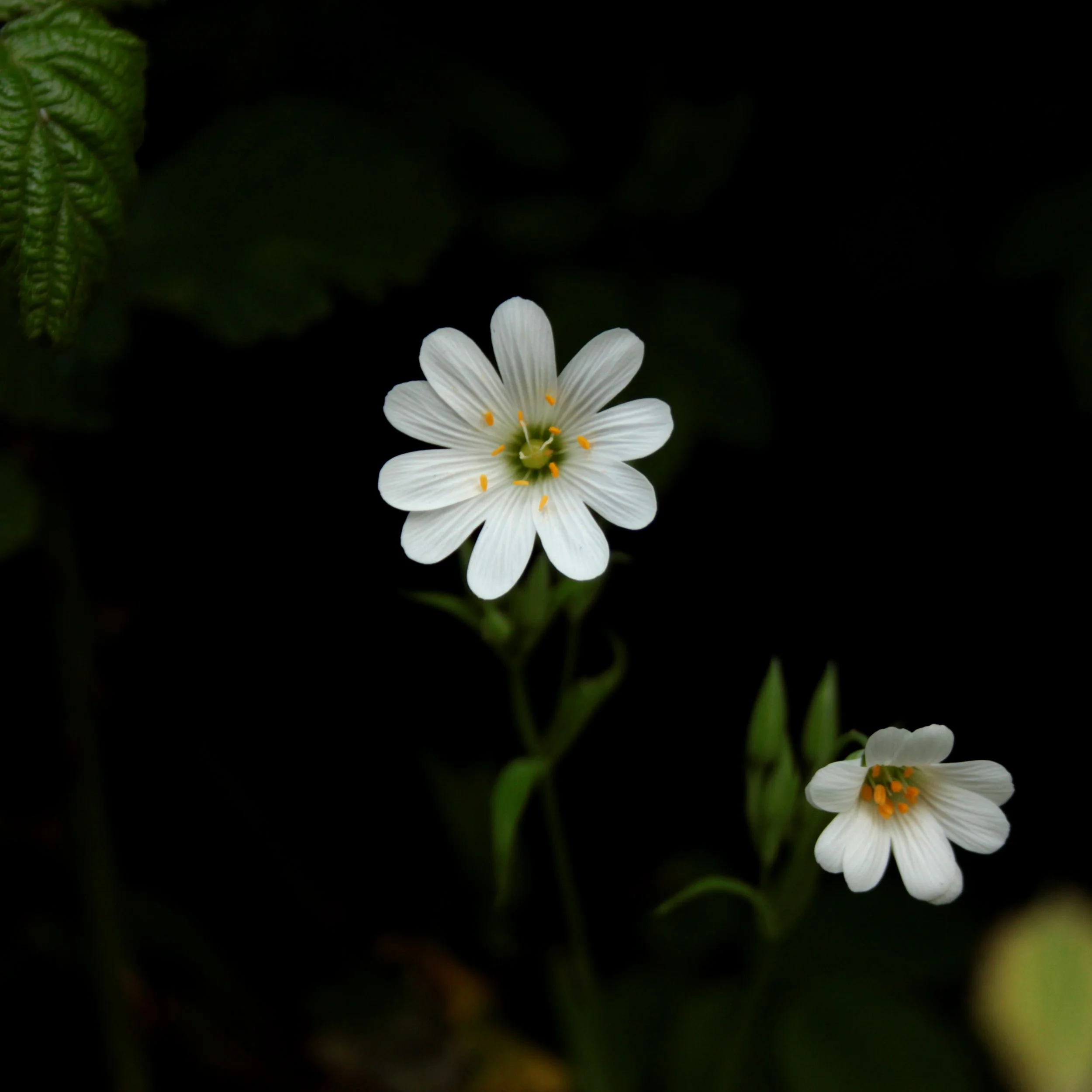17 June 2024
Dead Man’s Bones: Stars, Snakes and Explosive Seeds
Welsh common names: Serenllys Mawr, Bara Caws a Llaeth, Bara Can a Llaeth, Blodau’r Neidr, Tafod yr Edn Mwyaf, Bwyd y Neidr, Bwyd y Gog, Llysiau’r Glust
English common name: Greater Stitchwort
Scientific name: Rabelera holostea
Found in hedgerows and grassy verges from mid spring, the small flowers of Greater Stitchwort emerge from the thicket with a distinctive glow. Pale and ghostly in the undergrowth, the petals are deceptive, but - if you look closely - identifying this plant is easy: what appears to be ten slender lobes are actually a set of five deeply incised petals, spread like coattails below the dainty, pollen-tipped stamens.
Associated with both healing and bone-breaking, stitchwort has multiple historic medicinal uses, including the belief the plant eased the pain of side-stitches, as evidenced by its common English name. John Gerard’s 1597 Herball says to:
“drink it in wine with the pouder of Acornes, against the paine in the side, stitches and such like”.
The scientific name holosteon, is from Greek meaning ‘entire bone’, as the stems are brittle and easy to break, hence several other common names to do with snapping or breaking bones: ‘Dead Man’s Bones’, ‘Snapdragon’, ‘Snapper Flower’, ‘Brittle Bones’. Other, less gruesome descriptors, such as ‘Star of Bethlehem’ and the Welsh Serenllys Mawr refer to the celestial quality of the flower, both in shape and the way they softly glow like constellations in the gloom. ‘Seren' is Welsh for star, ‘llys’ is an archaic botanical term meaning plant, and ‘mawr’ means big, as in ‘greater’, to distinguish it from it’s little sister Lesser Stitchwort, who bears noticably smaller flowers.
In fact, none of the Welsh names I’ve come across refer to bone-breaking at all, but instead list things a child might eat for lunch, such as Bara Caws a Llaeth and Bara Can a Llaeth. The former translates to ‘bread, cheese and milk’ and the latter ‘milky white bread’, likely referring to the colour of the flowers and sustenance the plant offers to both pollinators and people. Stitchwort leaves and flowers are edible, although gathering enough for a meal would take a while, so perhaps the biggest benefits are for the insects who frequent the plant for its nectar, such as bees, hoverflies and the rare Wood White butterfly, as well as Marsh Pug, Plain Clay and Yellow Underwing moths whose larvae feast on the plant when hatched.
The popularity of Stitchwort’s nectar is further reflected in another Welsh name: Tafod yr Edn Mwyaf, meaning ‘Greater Bee’s Tongue’, (with greater probably describing the size of the flowers, rather than the proboscis.)
Further common English names include ‘Poor Man’s buttonhole’ and ‘Shirt buttons’ and it’s easy to imagine in days gone by a stem being picked and tucked into a collar in spring. ‘Addersmeat’, offers little explanation, supposedly originating from an old belief that picking the flowers would release snakes from their winter sleep. Two Welsh names also indicate a serpentine connection: Blodau’r Neidr, (Snake Flowers), and Bwyd y Neidr (Snake Meat). It’s possible the superstition developed from snakes emerging from hibernation coinciding with the appearance of Stitchwort in spring, but this is the case with all other hibernators, so the specific relationship to snakes remains a mystery.
The cuckoo is also associated with the plant, again, both the bird and the flowers emerging in spring, reflected in the Welsh name Bwyd y Gog; Cuckoo’s Meat - also a common English and Welsh name for Wood Sorrel. (Interestingly, no English common names for Stitchwort feature Cuckoo’s, just the Welsh.)
As the flower heads wilt to resemble paper lanterns, the seeds ripen within. Pressure builds inside the seed pods until they explode, scattering their seeds far and wide and making audible popping sounds which can be heard in late spring. This may be the inspiration for an intriguing Welsh name Llysiau’r Glust, translating to ‘Plant’s Ear’, with glust (from clust) meaning a physical ear and sense of hearing, attention and willingness to listen. Seeing as Stitchwort isn’t especially ear-shaped, perhaps the name reflects the audible seed dispersal, if only for those who are willing and attentive.
Disclaimer: don’t consume or use wild plants for health purposes without speaking to a medical professional first. Be cautious if foraging and only gather plants that you are certain of. These essays are intended to pique interest rather than act as a robust edible or medicinal guide.
Photos by Esther Williams, taken on Lower Quay Road in Hook, Pembrokeshire.




